M B Bayer, 16 Hope Str., 8000 Cape Town.
Ian Ritchie, Box 44, 5850 Somerset East.
Introduction
Kaboega (also spelt Kabouga) is now an assemblage of farms (De Plaat, Wilgerfontein, Vygeboomfontein, Klipfontein) nestled against the north slopes of the Zuurberg mountains, north of Kirkwood. It is only about 15km away from Kirkwood as the crow flies, but 150km away by road. Oudekraal is about 20km east and it is the source of Haworthia angustifolia var. baylissii and Gasteria baylissiana. There are several records of Haworthia for the Kirkwood area, and von Poellnitz named H. stiemiei (Regarded as insufficiently known and not recognised by Col C.L. Scott or myself) from there. He also identified plants from Kaboega and Uyepoort, both described as “at Kirkwood”) as H. altilinea var. denticulata (Haw.) V. Poelln. These plants are all in the melange that I attribute to H. cooperi var. gordoniana (the subject of another long essay). The Kaboega farm lies on the Kaboega river which drains an area of about 1m ha and then flows through the long Kaboegapoort into the Sundays River just north-west of Kirkwood. The terrain is very broken with the sandstone Zuurbergs themselves dominating the southern boundary at about 850 to 950m above sea level. The lowest point on the farm is at about 300m and the northern lesser shale or dolerite peaks reach 550 to 650m. The vegetation on the sandstones is Dry Mountain Fynbos. North of this is Karoo Valley Bushveld. Thus Kaboega is at an ecotone of the karoid veld, Eastern Cape grassland and the Noorsveld (Euphorbia thicket) of the Jansenville area.
The name Kaboega means ‘the Big Hole’, referring to the deep gorge which the Kaboega River cuts through the Zuurberg. This river joins the Sundays River where it skirts the eastern end of the Kleinwinterhoek Mountains. Thus Kaboega Gorge is about 20km east of the Sundays River Gorge and 20km west of Oudekraal where the Witrivier also cuts through the Zuurberg flowing southwards.
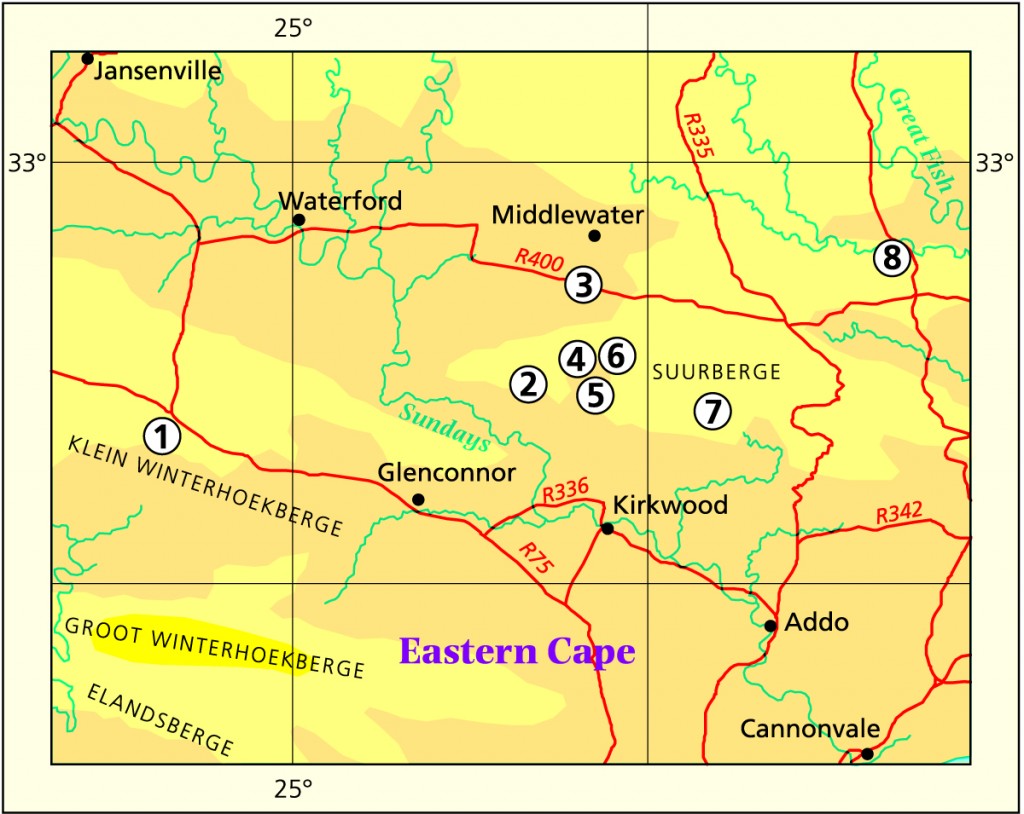
1- Wolven, 2- Wilgerfontein, 3- Paddfontein, 4- Spitzkop, 5- Die Plaat, 6- Hopewell, 7- Oudekraal, 8- Ripon.
The only known Haworthia collections from Kaboega prior to this report are two collection by Gerhard Marx (JDV91/14-145, JDV91/15-146) from the easterly part of the farm (DePlaat, north and south aspects), and a similar collection by Peter Bruyns (PVB5002 in JDV92/33-147) from Kaboegapoort itself. Discounting the strange (expected) internal variation in the latter, these three collections are fairly similar. Plants with the brighter yellow-green of H. cymbiformis, but with more terete and slender sub-erect leaves. The plants are quite robust and in cultivation reach about 80mm diam. with leaves up to 90mm long. Look-alikes are found in the gracilis, cooperi and cymbiformis var. transiens complex of the Baviaanspoort, and I have generally referred these all to H. cooperi var. gordoniana. However, that variety is actually quite a distinctive one from the Hankey Pass, north of Humansdorp and perhaps I should never have adopted it for general use in the way I have. Thus in my discussion about H. cooperi and H. bolusii var. blackbeardiana, I speculate that gracilis is an archetypal form which may lie at the root of the Eastern Cape species here being discussed.
The species H. aristata poses similar problem, and so does H. decipiens var. pringlei (Scott) Bayer as well as two collections which I and Bruyns made at Ripon station which is north-east of Kaboega. One of these latter collections is H. cooperi var. pilifera (-111) and the other is H. decipiens var. pringlei (-112). Largely because of that collection, I felt pressured into believing that the latter would best be coupled with H. bolusii var. blackbeardiana rather than with H. decipiens, and I was contemplating a major change of this kind. This would also have involved subsuming that element in an enlarged H. cooperi var. cooperi. There are, however, some other collections from the greater Darlington Dam (Lake Mentz) area to the west, which are relevant to this problem. These include older ones which suggested the link of pringlei with decipiens which I was thus also predicting, and new ones which confirm that this does in fact happen.
Because of the extent and complexity of the problem, this report deals specifically with the Kaboega area. In conjunction with it, a manuscript regarding H. cymbiformis var. incurvula, was written to give another indication of the nature and scope of the problem of classification of Haworthia. However, the chief reason for the visit to Kaboega was somewhat fortuitous. I was intending visiting Pluto’s Vale again, also the farm Thornkloof where Col. R. Bayliss had collected; the place Aalwynpoort to check on an Ernst van Jaarsveld collection and also hoping to cast light on a collection from the Bosberg at Somerset East. Peter Bruyns was hoping I would recollect a Stapelia aff. kougabergensis which he had seen on the Zuurberg, and there are also some other Haworthia records in that general area which need verification. What also materialised was a visit by Steven Hammer to South Africa, and contact with Tony Dold of the Shonland Herbarium at Grahamstown. The best of all was contact by my wife Daphne, with the gracious managers of the Kaboega farming enterprise, Sandy and Ian Ritchie. Through their kindness and hospitality we came to spend four days on the farm and briefly explored what it has to offer. One day there was spent with Steven Hammer, and with Tony Dold and Dez Weekes of Grahamstown. My wife and I returned for a second visit in Sept. ’99, when we also went to Oudekraal via a direct farm road from Kaboega to the east.
Results
On our first visit we first explored the western side of the farm known as Wilgefontein. Tony and Dez went up the slopes of the Spekboomberg on the north side of the valley, and the remainder of the party climbed to near the top of the Zuurberg. We climbed straight to the grassveld where the grass was very long and thick. We soon found a solitary-growing greyish-green plant in flower (MBB6904-148), and then higher and on vertical rocks, a less translucent clump-forming plant with a velvety texture – also in flower (MBB6905-149). The plants looked rather different and we were quite excited about it being something apparently out of the ordinary. It is possible in the context of later collections, that these two collections are ecotypes. Looking at similar rocks about 200m to the south-east, we found what at first was obviously H. coarctata var. adelaidensis (MBB6907). This turned out to be a big population of plants which can, as such, be collectively regarded as intermediate between H. glauca and H. coarctata. This is a very significant collection because of the occurrence of glauca in its typical form at Zuurberg Pass, and nearer at Oudekraal, both to the east. Var. coarctata itself is not known nearer than at Patterson 70km eastwards and var. adelaidensis from east of Riebeek East which is still further away. (see also ‘Haworthia Revisited’ p179). What we did hope to see was H. angustifolia known at its western limit from Oudekraal. It must be on Kaboega and we just have not seen it yet.
Across the valley Dez Weekes had collected three specimens from a south facing steep cliff (MBB6903-150). These had long stems with bright green terminal rosettes and I have identified these as H. cymbiformis (with reservations! as I think this could again be a local ecotypic adaptation) without seeing the plants in habitat myself. This species is also not known from nearer than Hell’s Gate 50km to the south, but – it almost certainly has affinities with the plants collected by Marx and Bruyns. Steven Tony and Dez had to leave after the first day, but Daphne and I continued the exploration the second day with a long climb up the hill east of DePlaat. We soon found Gerhard Marx’ (MBB6909-151) plants at the base of the mountain and continued eastwards and upwards. We came across a very extensive and dense mass of H. glauca (MBB6908). The plants were variously tubercled and lacked the distinctive grey colouration of the species. Any affinity with “coarcata” was less obvious than at Wilgefontein. Another interesting plant there was a dwarf form of Aloe tenuior. We crossed over to the steep north slopes and on the way down came across three plants (MBB6910-152) of what appeared to be similar to the velvety plant of the previous day (-149). It was in the same rocky situation. We looked further for it, but failed to find it again probably only for lack of concerted effort. The terrain was very difficult and we were getting a little hot and tired. We came across the Marx plants again. These were further down the hill and looking rather bleached in the sun.
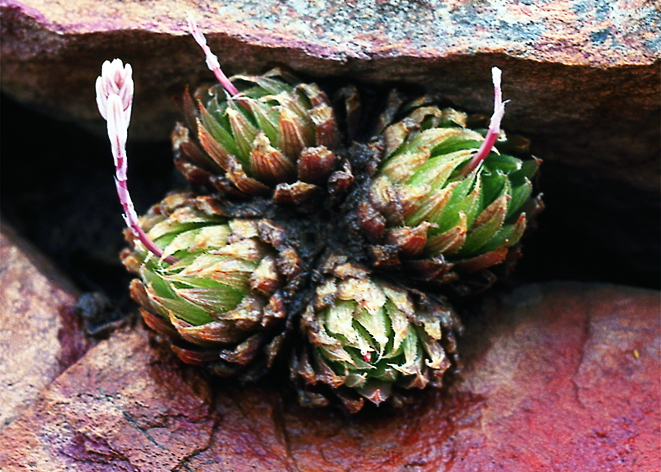
149 a. MBB6905 H. gracilis var. isabellae, on rock face, Wilgefontein, westof Kaboega. 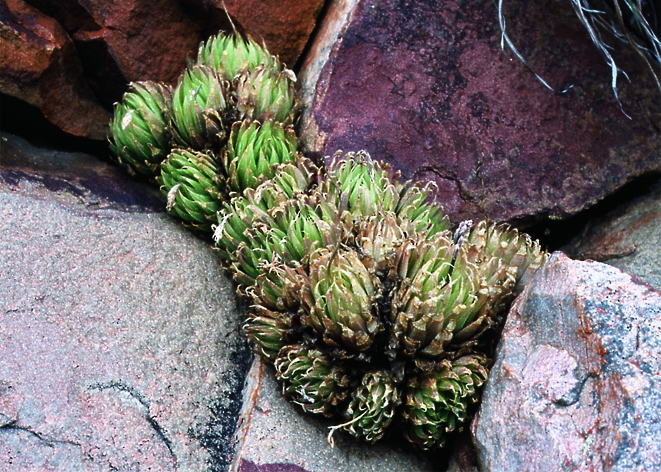
149 b. MBB6905 H. gracilis var. isabellae, on rock face, Wilgefontein, westof Kaboega. 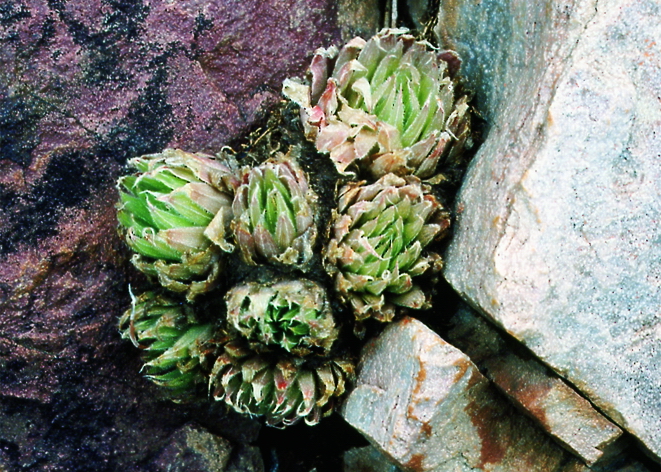
149 c. MBB6905 H. gracilis var. isabellae, on rock face, Wilgefontein, westof Kaboega. 
149 d. MBB6905 H. gracilis var. isabellae, Wilgefontein, west of Kaboega. 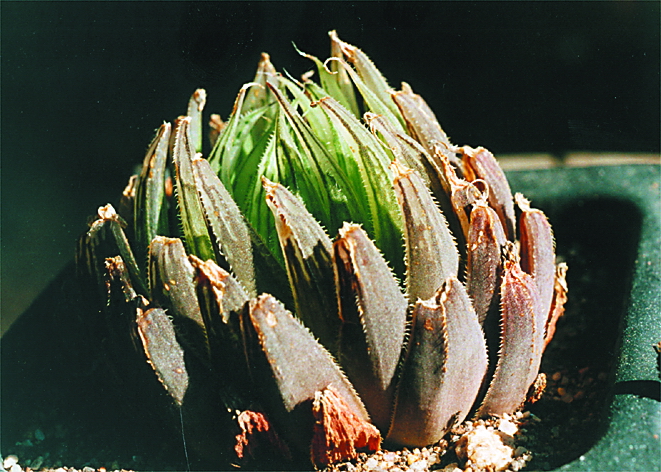
149 e. MBB6905 H. gracilis var. isabellae, Wilgefontein, west of Kaboega. 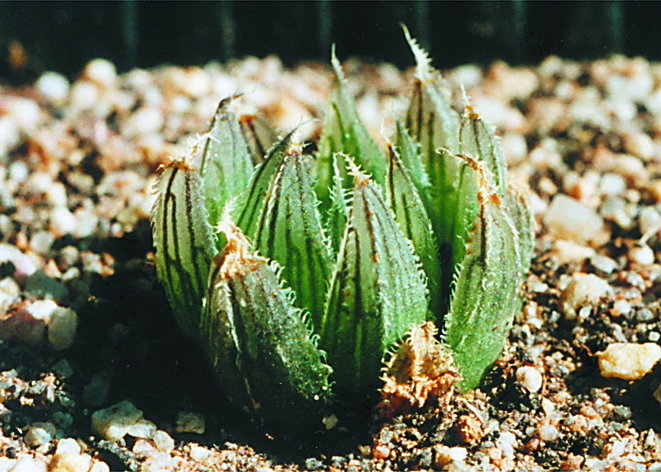
149 f. MBB6905 H. gracilis var. isabellae, Wilgefontein, west of Kaboega. 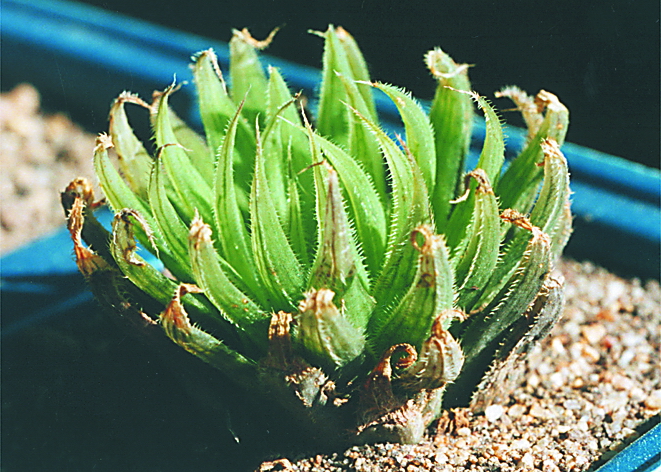
149 g. MBB6905 H. gracilis var. isabellae, Wilgefontein, west of Kaboega. 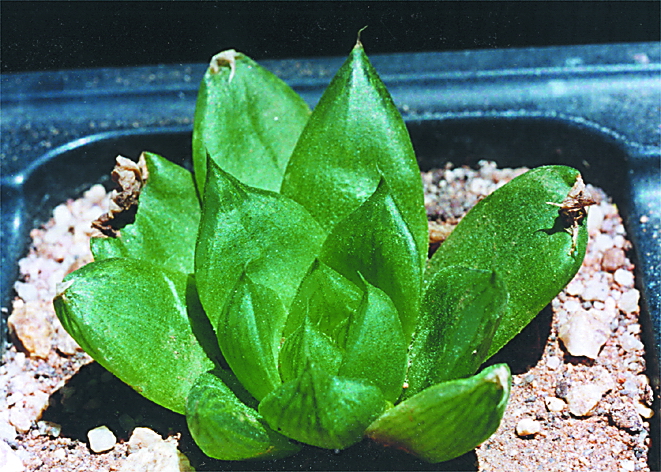
150. MBB6903 H. cymbiformis var. cymbiformis. south-facing rocks, Wilgefontein. 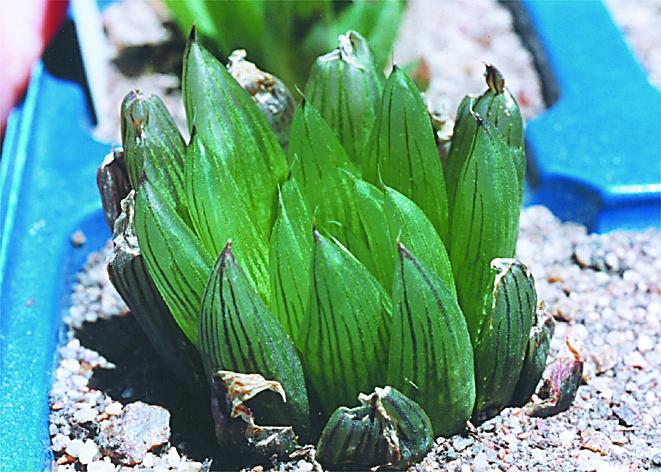
151. MBB6909 H. cooperi var. cooperi, southwest fo De Plaat farmhouse. 
152 a. MBB6910 H. gracilis var. isabellae to H. cooperi var. cooperi, east of De Plaat farmhouse. 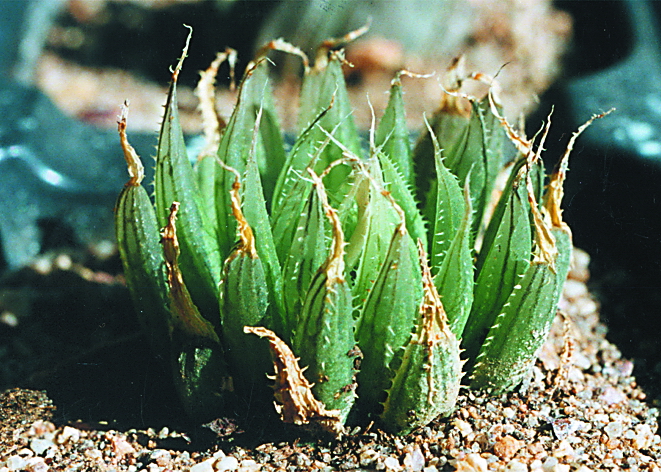
152 b. MBB6910 H. gracilis var. isabellae to H. cooperi var. cooperi, east of De Plaat farmhouse.
On the way home we were travelling across some very stony ground covered with scattered bush and a low-growing Felicia, probably filifolia. Underneath these, in algae and moss, and with Euphorbia stellata and Tylecodon reticulatus were single plants of a cryptic small blue-green species (MBB6917-142). This I relate to collections from Stonefountain and Verdun cited in my revision under H. aristata, again collected as MBB6852-126 and Dold in MBB6851-125 (Modderfontein).
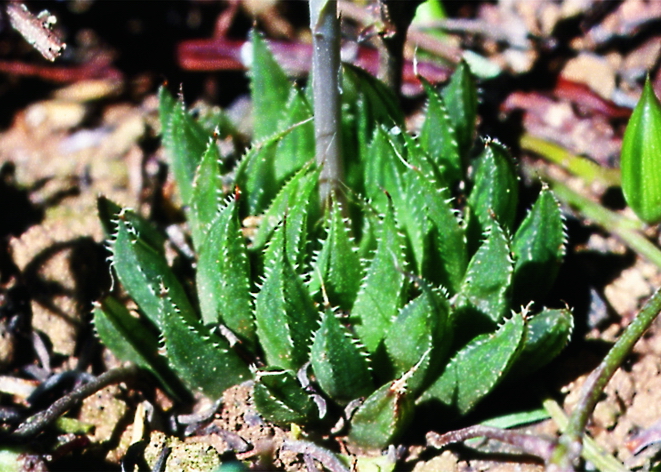
142 a. MBB6917 H. aristata, Kaboega. 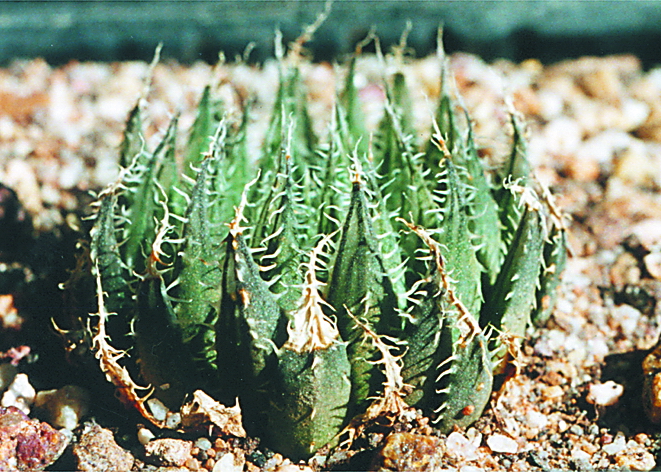
142 b. MBB6917 H. aristata, Kaboega. 
142 c. MBB6917 H. aristata, Kaboega.
The following day, accompanied by Sandy Ritchie, we ventured into the Kaboegapoort itself. We walked to the boundary with the Addo National Park. On the way we had seen inaccessible clumps of an Haworthia on a very steep cliff and we tried to reach these on the way back. We were lucky to be able to sample four clumps on the first of the rock faces where some plants had established themselves off the face (MBB6911-153). On the other cliff we could not reach anything. The plants were not cymbiformis but relate rather to the Marx plants except that they were clump-forming and bleached. A better comparison is with (-148). They were also in flower.
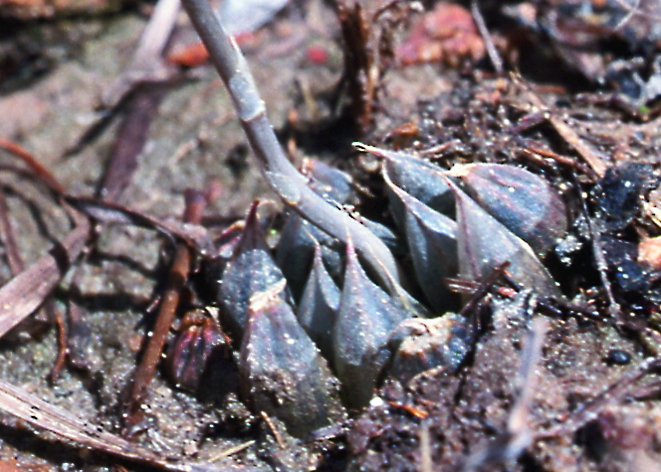
148 a. MBB6904 H. cooperi var. cooperi, in amongst grass, Wilgefontein, west of Kaboega. 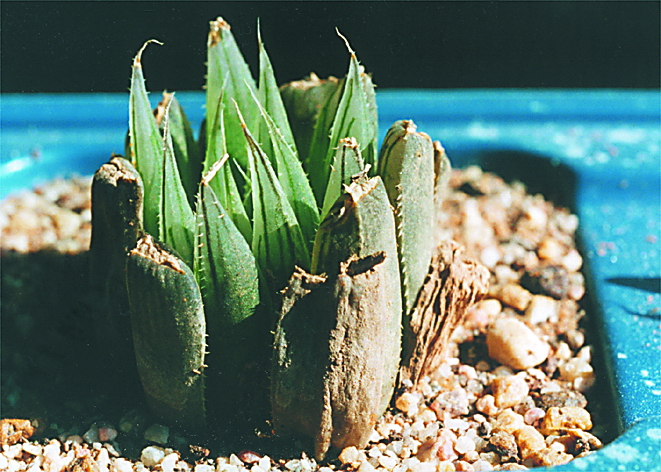
148 b. MBB6904 H. cooperi var. cooperi, in amongst grass, Wilgefontein, west of Kaboega. 
148 c. MBB6904 H. cooperi var. cooperi, in amongst grass, Wilgefontein, west of Kaboega. 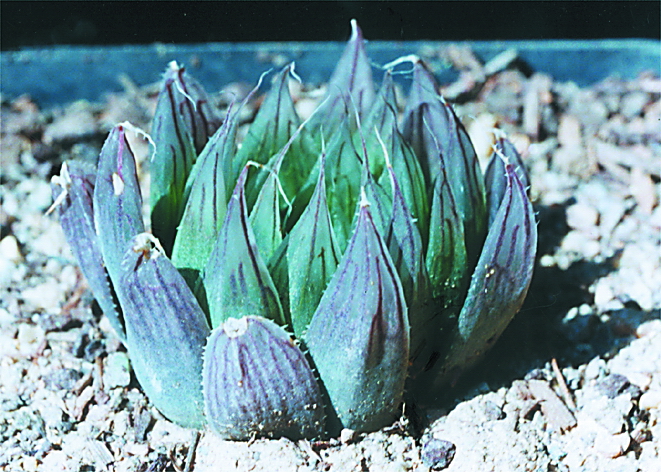
148 d. MBB6904 H. cooperi var. cooperi, in amongst grass, Wilgefontein, west of Kaboega. 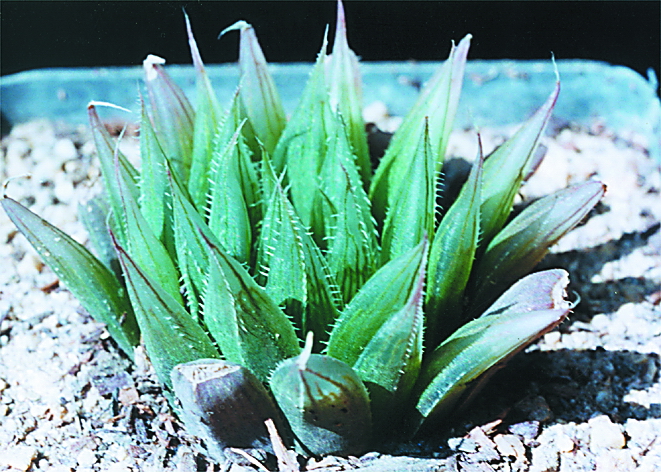
148 e. MBB6904 H. cooperi var. cooperi, in amongst grass, Wilgefontein, west of Kaboega. 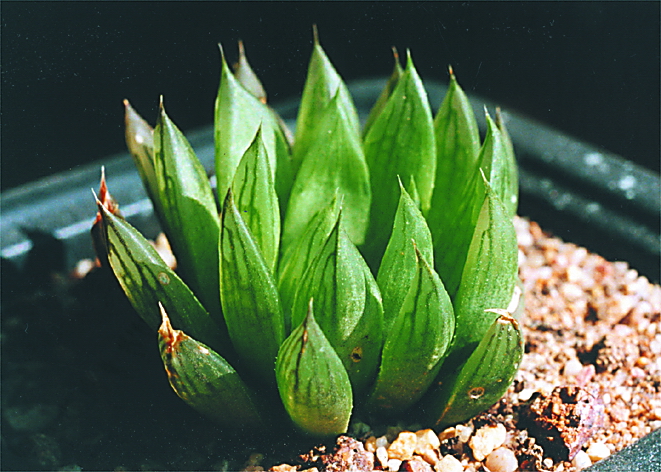
153. MBB6911 H. gracilis var isabellae to H. cooperi var. cooperi, rock faces in Kaboegapoort.
Peter Bruyns collection (-147) is of six clones from this poort and each of these plants is different. However, one clone (-147.1) resembles gracilis var. viridis from Perdepoort (-70) and also resembles a collection of Bruyns of cymbiformis var. transiens (-69) from the Langkloof. (This latter collection is involved in the issue of that species or gracilis var. picturata). Kobus Venter also has a collection of similar plants from south of Lake Mentz (-72.2). A second clone (-147.2) was an aberrant plant with very terete, abruptly mucronate leaves which were also unusually translucent. Another clone (-147.3) was of a plant identical to the big gracilis var. isabellae of the Krom River Estuary (Ripon, WRB1, recollected by myself -39), and comparable with a collection (MBB6855-154) from Waterford, east of Jansenville. That collection could be identifiable as H. arachnoidea var. xiphiophylla and perhaps hinting at a link of that element with H. decipiens var. minor. Two clones (147.4, 147,5) are the same as the DePlaat collections (-145, -146), resembling the Gladhurst (-116) and Glen Craig (-98,-99) forms of gracilis. Thus representing my view of an archetype.
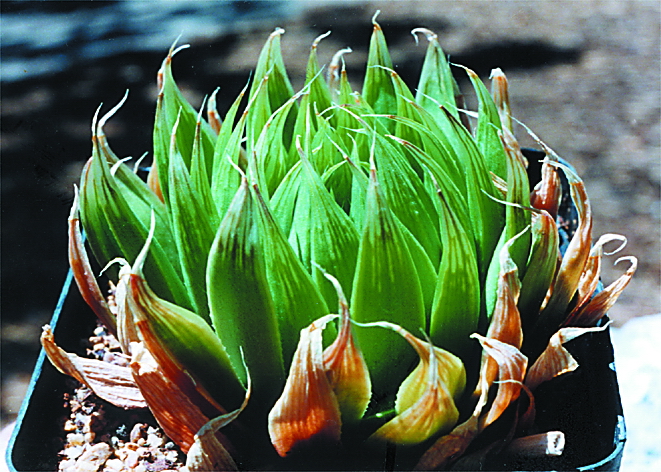
147 a. PVB5002 in JDV92/33 H. cooperi var. cooperi, Kaboegapoort cf [51 a-c]. 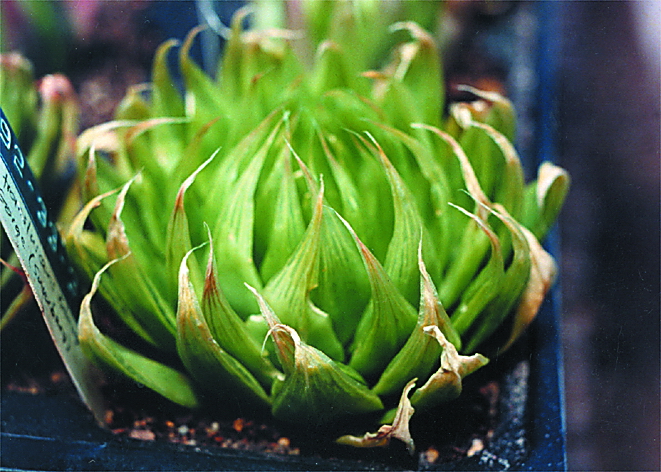
147 b. PVB5002 in JDV92/33 H. cooperi var. cooperi, Kaboegapoort cf [51 a-c]. 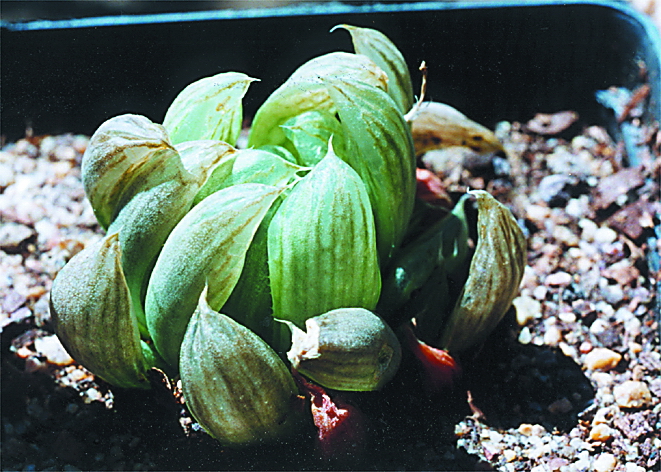
147 c. PVB5002 in JDV92/33 aberrant. 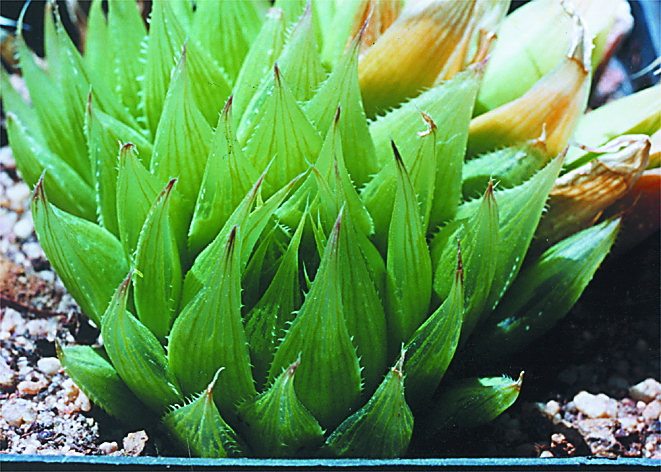
147 d. PVB5002 in JDV92/33 cf [20, 154 a-c]. 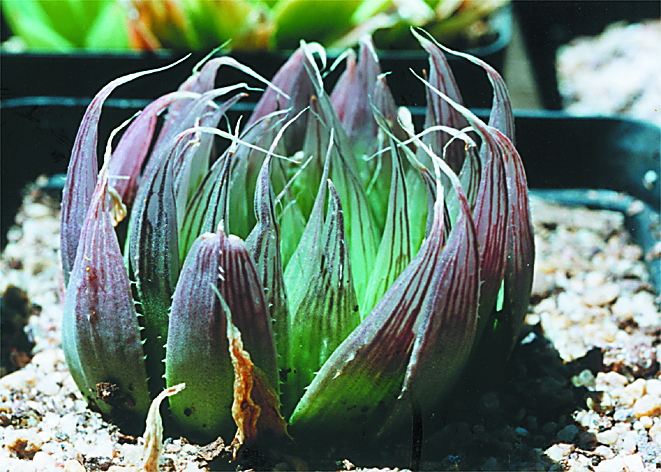
147 e. PVB5002 in JDV92/33 cf.095 [96 a, b, 116a-e]. 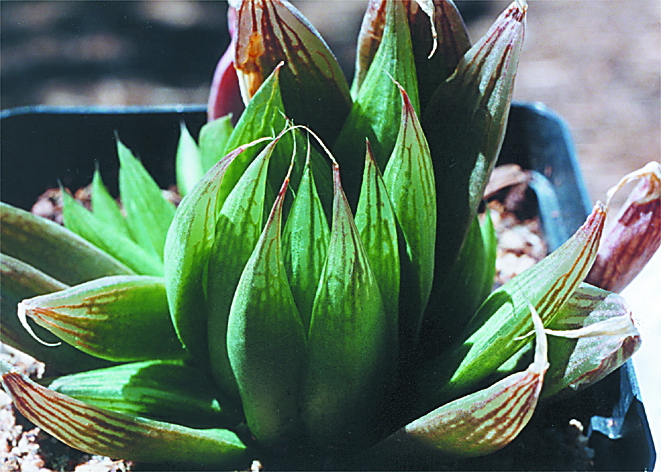
147 f. PVB5002 in JDV92/33 cf.095 [96 a, b, 116a-e]. 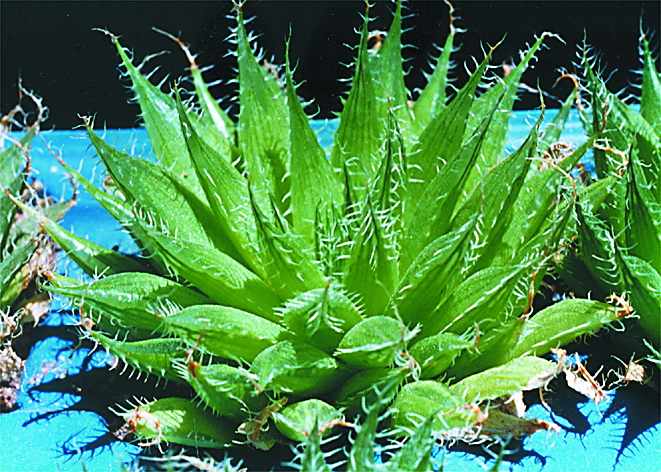
154 a. MBB6855 H. arachnoidea var. xiphiophylla to H. decpiens var. minor, Waterford, east of Janesville. 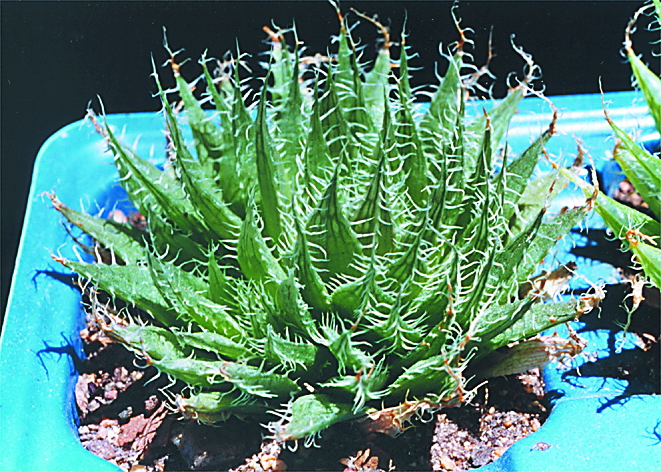
154 b. MBB6855 H. arachnoidea var. xiphiophylla to H. decpiens var. minor, Waterford, east of Janesville. 
154 c. MBB6855 H. arachnoidea var. xiphiophylla to H. decpiens var. minor, Waterford, east of Janesville.
On our last day, Ian Ritchie kindly took us on a drive to territory which had looked quite visitor friendly from the top of the Zuurberg. On closer contact they are anything but so. On the Spitzkop, which is on the northern boundary of the farm, we found aristata (-141) growing on bluish shale in a situation favoured by H. cooperi var. cooperi. It was a little bigger than our previous collection, but smaller than plants we subsequently collected northwards on the road between Riebeek East and Jansenville (Paddafontain, MBB6899-155), which I refer to pringlei) . Driving to the east of Spekboomberg we saw plants (MBB6914-156) similar to the Marx plants of DePlaat (-145) in profusion, some of them without the softer translucence of the Marx collection. The leaves were occasionally much flatter and ovate and distinctly reminiscent of cymbiformis. Daphne and I walked down the hill from that point seeing the plants for most of the descent. Ian in the meantime drove back and further to the south-east and then found very similar plants on a steep slope also facing south-east (MBB6915-157). These plants can also occur in large clusters.

141 a. MBB6916 H. aristata, Spitzko[, Kaboega. 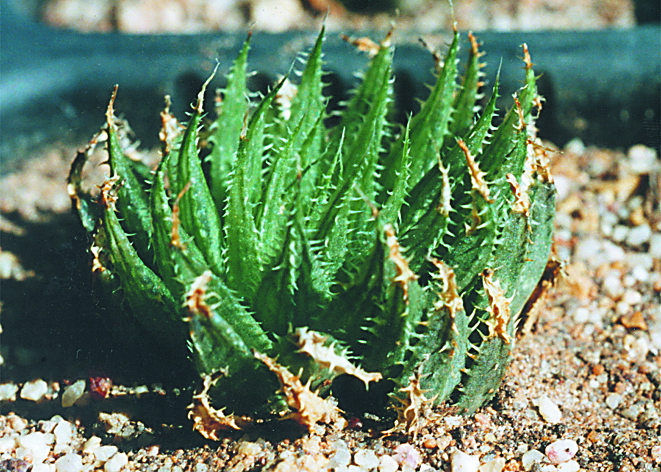
141 b. MBB6916 H. aristata, Spitzko[, Kaboega. 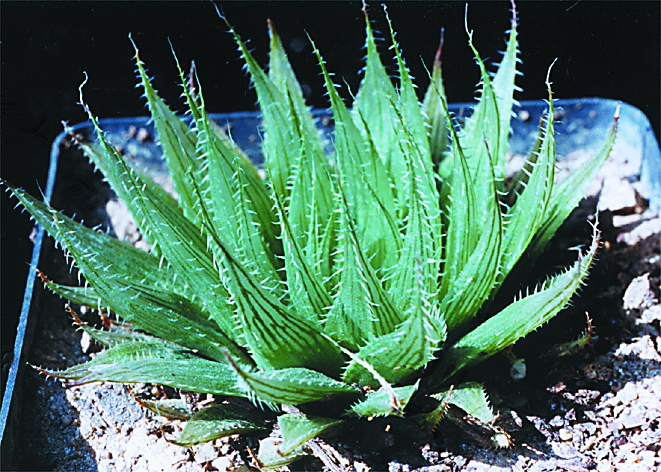
141 c. MBB6916 H. aristata, Spitzko[, Kaboega. 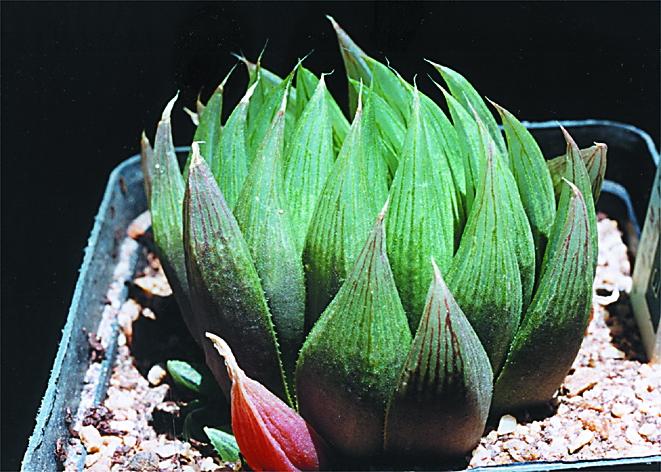
145 a. J.G.Marx in JDV91/14 H. cooperi var. cooperi, De Plaat, north aspect, Zuurberg. 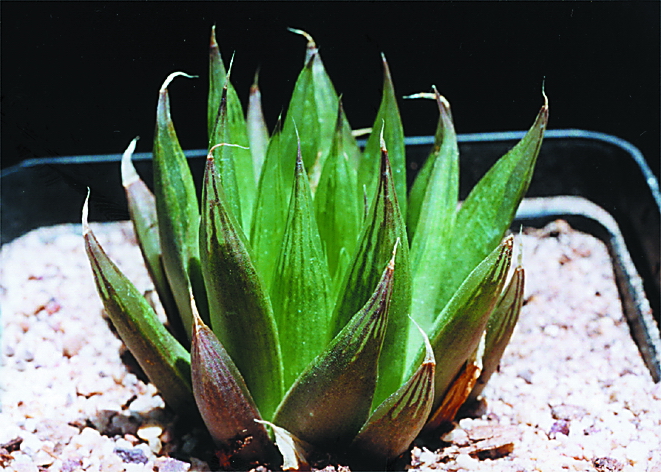
145 b. J.G.Marx in JDV91/14 H. cooperi var. cooperi, De Plaat, north aspect, Zuurberg. 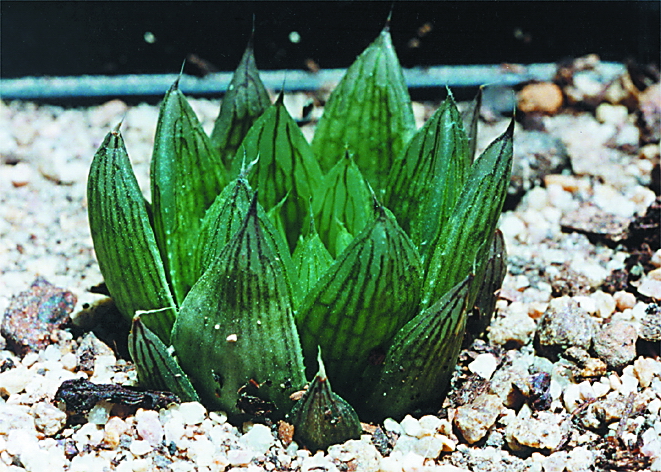
145 a. J.G.Marx in JDV91/14 H. cooperi var. cooperi, De Plaat, north aspect, Zuurberg. 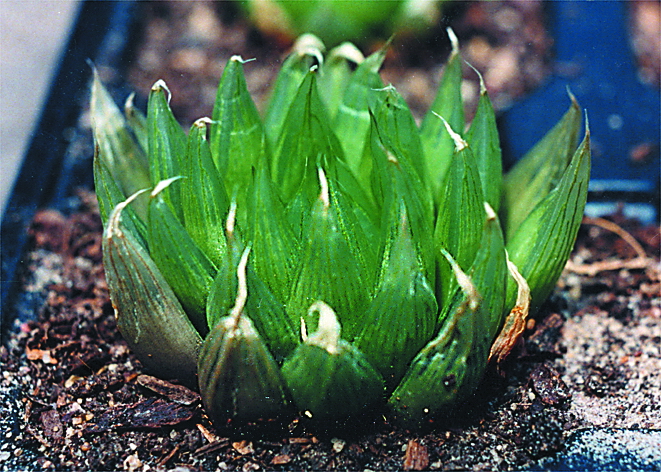
145 d. J.G.Marx in JDV91/14 H. cooperi var. cooperi, De Plaat, north aspect, Zuurberg. 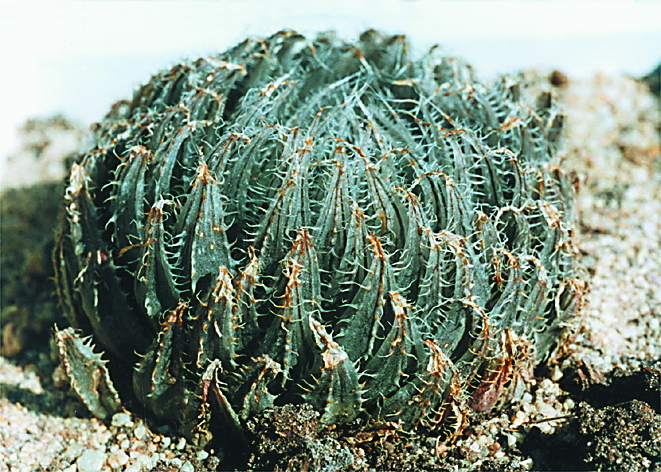
155. MBB6899 H. aristata / H. decipiens var. pringlei, Paddafontein, north of Kaboega. 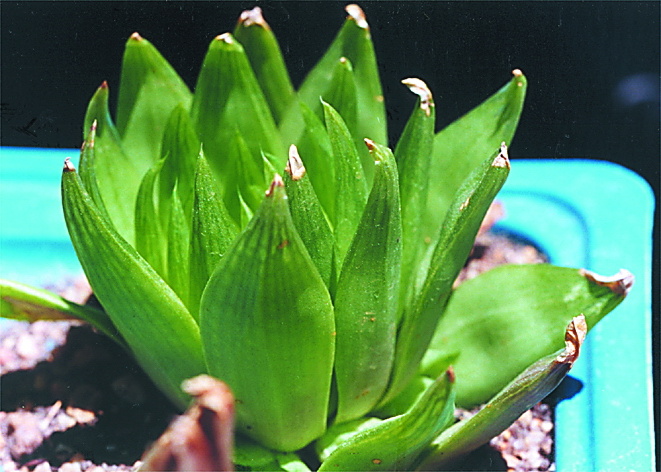
156 a. MBB6914 H. cooperi var. cooperi / H. cymbiformis, east of Spekboomberg, northwest of Kaboega. 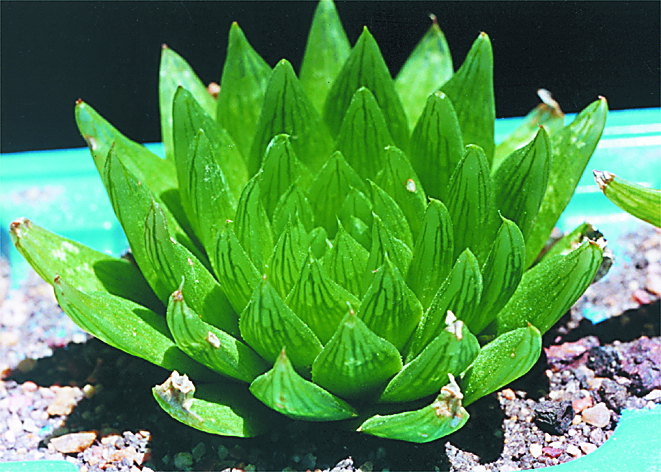
156 b. MBB6914 H. cooperi var. cooperi / H. cymbiformis, east of Spekboomberg, northwest of Kaboega. 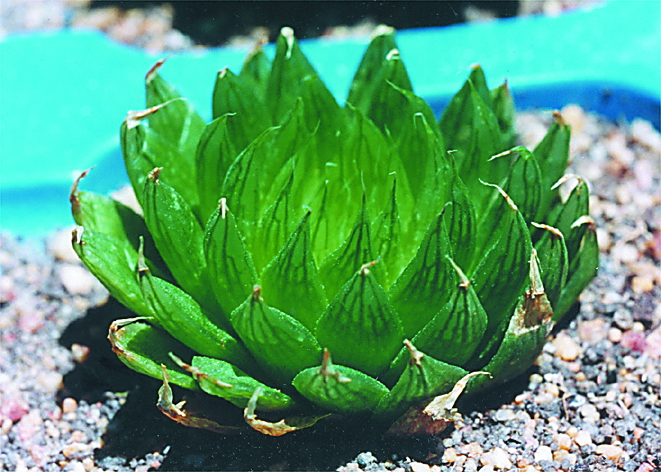
156 c. MBB6914 H. cooperi var. cooperi / H. cymbiformis, east of Spekboomberg, northwest of Kaboega. 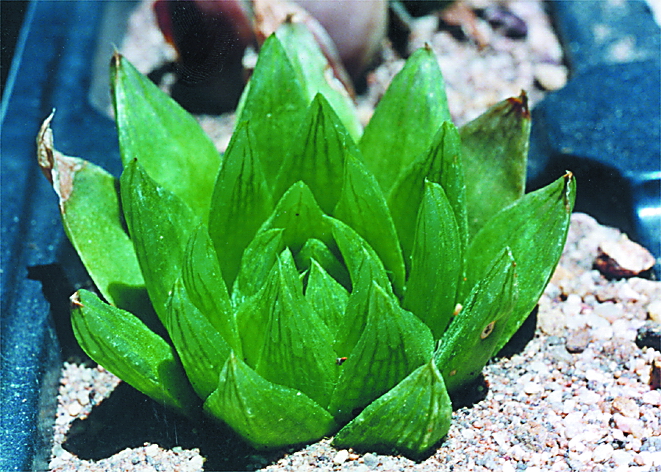
157 a. MBB6915 H. cooperi var. cooperi / H. cymbiformis, Kok-se-dam, Kaboega. 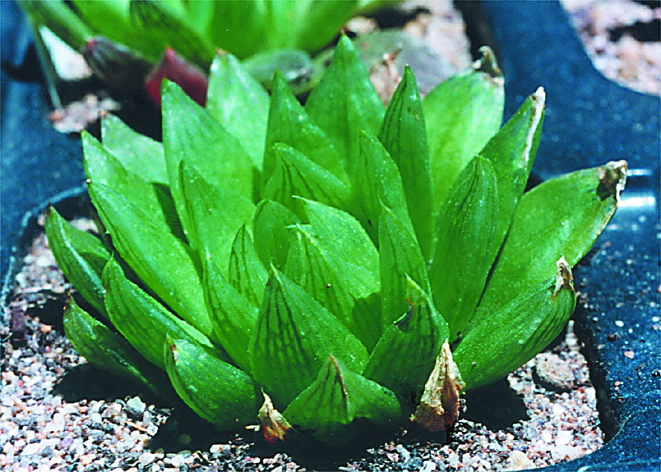
157 b. MBB6915 H. cooperi var. cooperi / H. cymbiformis, Kok-se-dam, Kaboega.
Daphne and I drove to Somerset East to reconnoitre the Bosberg and on the way back saw aristata again about 10km north-east of Kaboega (-143). We had looked at the Paddafontein (-155) plants on the way out and they quite obviously can be linked to aristata too. Unlike the other collections of aristata, however, the Paddafontein plants have a large robust inflorescence with many flowers open (usual in decipiens) as opposed to say the Commadagga (-128), aristata, but with fewer and stumpier leaves) dwarfs with only 8-10 flowers per stalk and one open at a time (thus more pilifera-like).
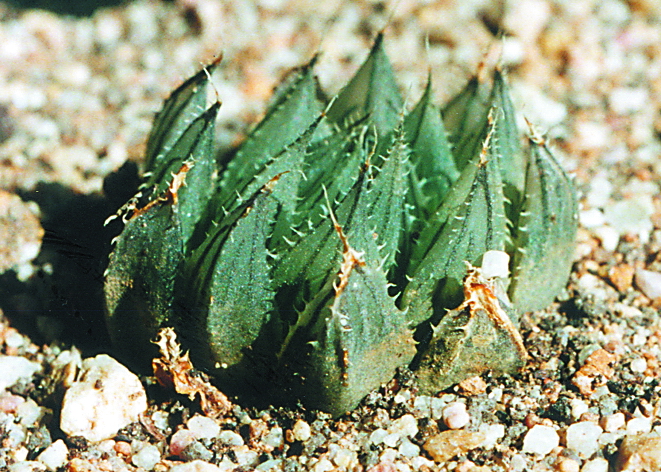
128 a. MBB 6897 H. aristata, southeast of Commadagga. 
128 b. MBB 6897 H. aristata, southeast of Commadagga. 
143 a. MBB6901 H. aristata, Hopewell. 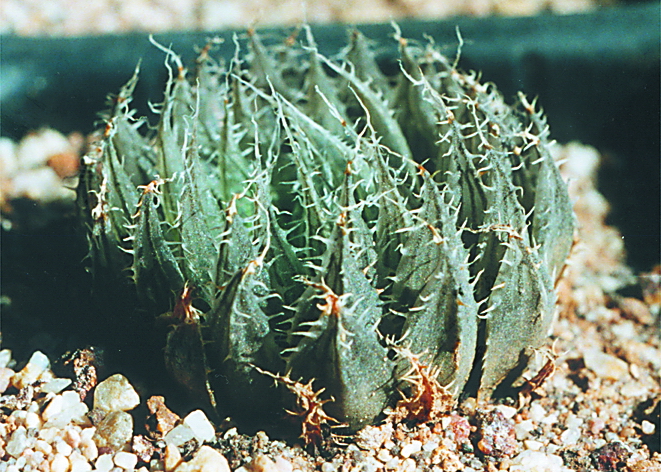
143 b. MBB6901 H. aristata, Hopewell. 
155. MBB6899 H. aristata / H. decipiens var. pringlei, Paddafontein, north of Kaboega.
During our second visit, we again went to the top of the mountain at Wilgefontein, after Ian had shown us H. glauca in the Kaboegapoort itself. This population was not typical of the species and also more like the De Plaat plants. We revisited the site of -148 and -149. Both were in flower and on this occasion we found the grassy ecotype within about 75m of the stone-face plants. The latter had flowered but seed-set was very poor, as opposed to the grass element which had well-formed capsules. From there we went to the Dez Weekes’ slopes via a different route and collected (MBB6925-158) plants ranging from the same greenish cymbiformis-like plants of -156 to specimens which could be nothing else but typical of true cymbiformis. We saw the same plants again at the dam to the north-west of the homestead, and again on the south slopes (-159) behind the previous De Plaat collection (-151). We completed the stay with a visit to Soutkloof where we saw again the true aristata (-139), and also to the office of the Addo National Park on top of the Zuurberg. Here we saw specimens of H. cooperi var. pilifera from that vicinity, and similar to a collection by Ernst Van Jaarsveld from Oudekraal (I had seen these plants when I collected H. angustifolia var. baylissii there many years ago). On our visit to Oudekraal we stopped to the west of my previous visit and probably also west of where Ernst had collected. We found the cooperi-like plants (MBB6922-160) again growing among rocks in dense grassland. The plants had very pronounced reddish-lines in the leaves and this was evident in all the Kaboega collections.

158 a. MBB6925 H. cymbiformis var. cymbiformis, Kok-se-pad. 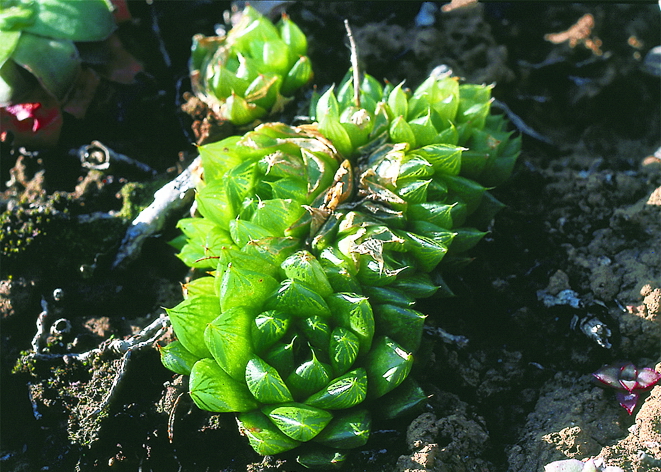
158 b. MBB6925 H. cymbiformis var. cymbiformis, Kok-se-pad. 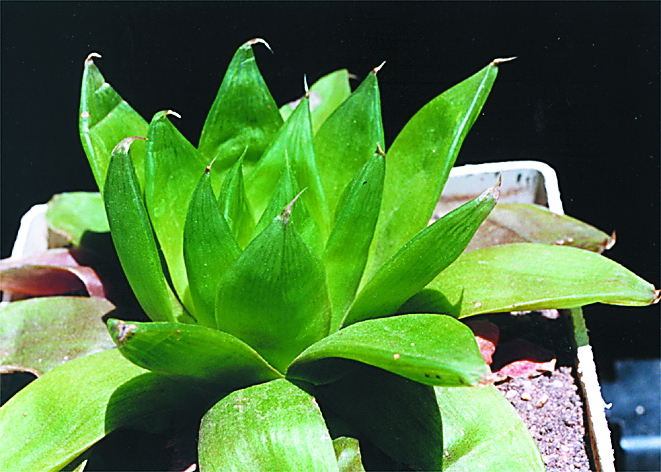
158 c. MBB6925 H. cymbiformis var. cymbiformis, Kok-se-pad. 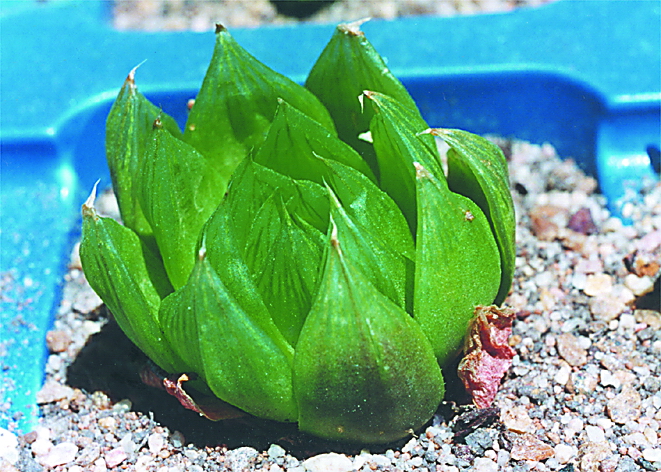
158 d. MBB6925 H. cymbiformis var. cymbiformis, Kok-se-pad. 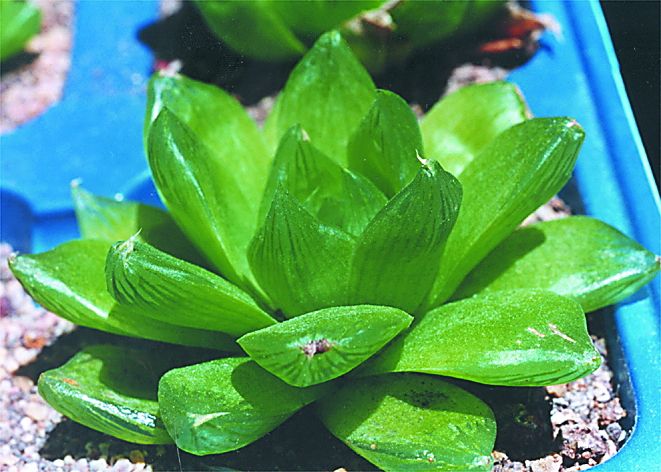
158 e. MBB6925 H. cymbiformis var. cymbiformis, Kok-se-pad. 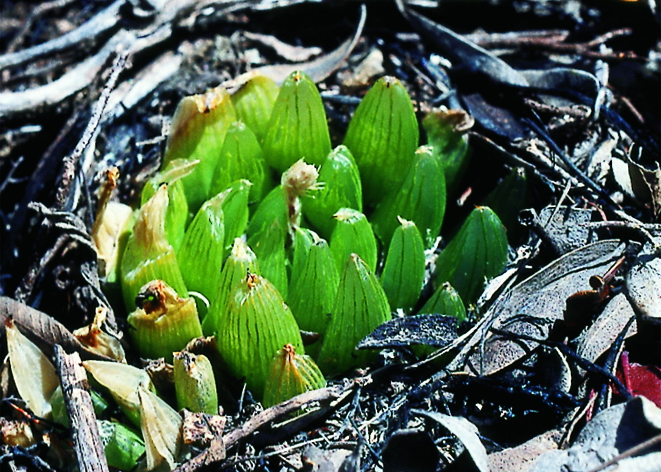
159 a. MBB6935 H. cooperi var. cooperi / H. cymbiformis, south of De Plaat farmhouse. 
159 b. MBB6935 H. cooperi var. cooperi / H. cymbiformis, south of De Plaat farmhouse. 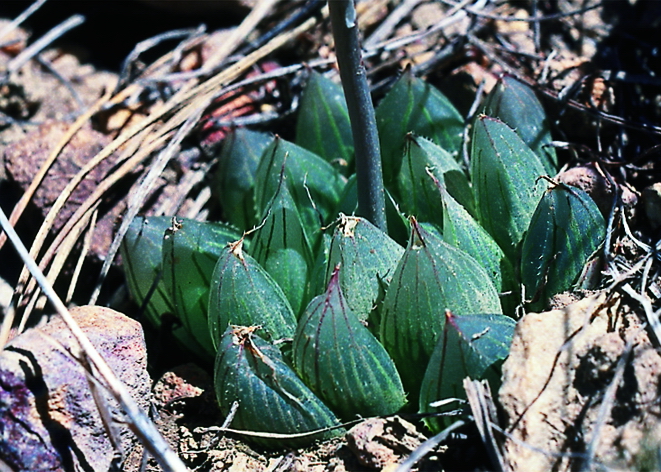
160 a. MBB6922 H. cooperi var. cooperi. Oudekraal, Zuurberg. 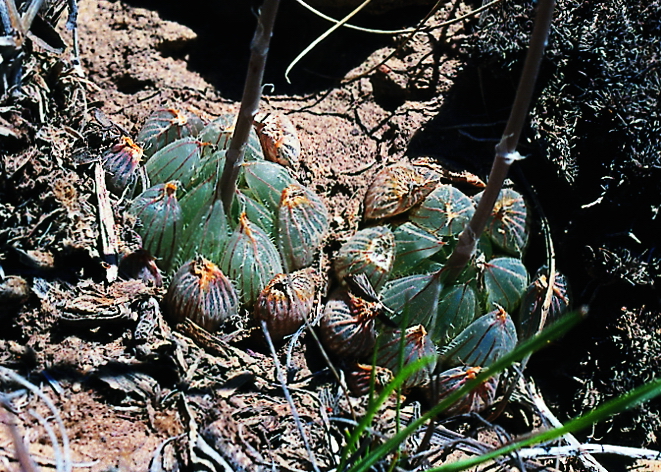
160 b. MBB6922 H. cooperi var. cooperi. Oudekraal, Zuurberg. 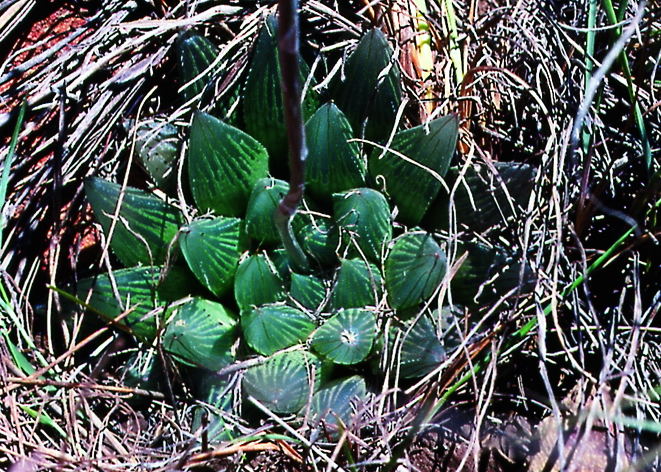
160 c. MBB6922 H. cooperi var. cooperi. Oudekraal, Zuurberg.
Curiously a post-graduate botany student busy with a study of succulent endemism brought in a number of plants for identification. This is P. Desmett, and among his collections, two are relevant. One is PD2310-161 from Boplaas. This is north-east of Kirkwood where the Kaboega meets the Sundays River. The plant is a small spinose specimen which could relate to the arachnoidea-like (as von Poellnitz compared it) stiemiei. It could alternatively, and because of its colour and translucent patterning of the leaves, be more probably compared with H. decipiens var. minor represented by several MBB collections from Sapkamma (MBB6618-162, MBB6619-163, MBB6620-164) to the west. The other is PD2309-165 from the southern end of Kaboegapoort. It is the apparently puberulous-like element resembling -148, and also -153. Kobus Venter also collected and aristata-like plant from the Sundays River Poort (-73) which I think compares very favourably indeed with a large number of collections from afar afield as Redcliffe (north-east of Willowmore), the Baviaanskloof, Uniondale, down the Longkloof to Humansdorp and Hankey/Patensie. These are all collections which I have identified as H. cooperi var. gordoniana, and considered in the context of another paper.
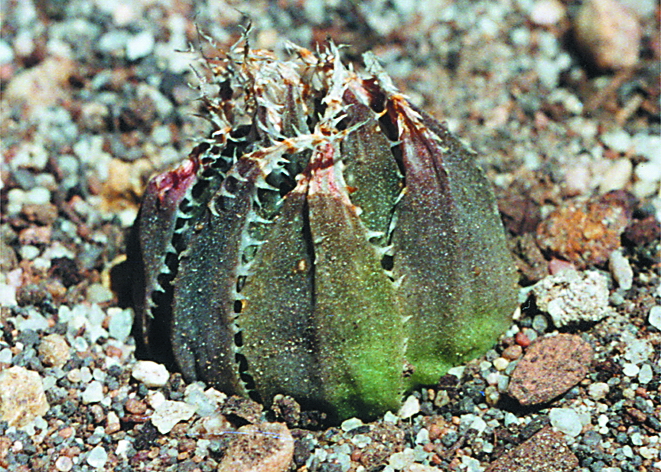
161. PVB2310 H. decipiens var. major, Boplas, northeast of Kirkwood. 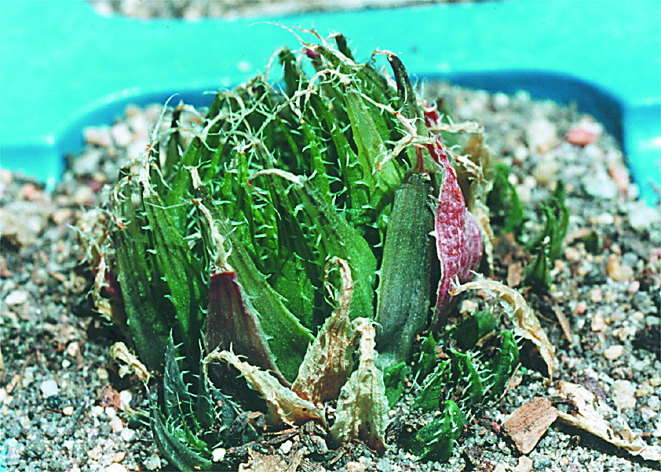
162 a. MBB6618 H. decipiens var. minor / H. arachnoidea var. xiphiophylla, Sapkamma, south of Perdepoort. 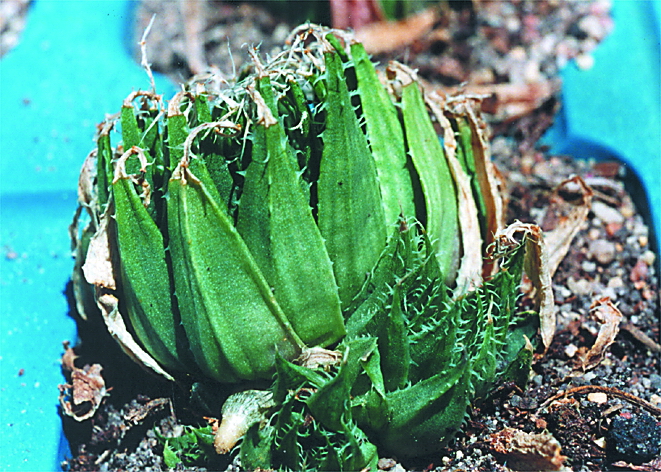
162 b. MBB6618 H. decipiens var. minor / H. arachnoidea var. xiphiophylla, Sapkamma, south of Perdepoort. 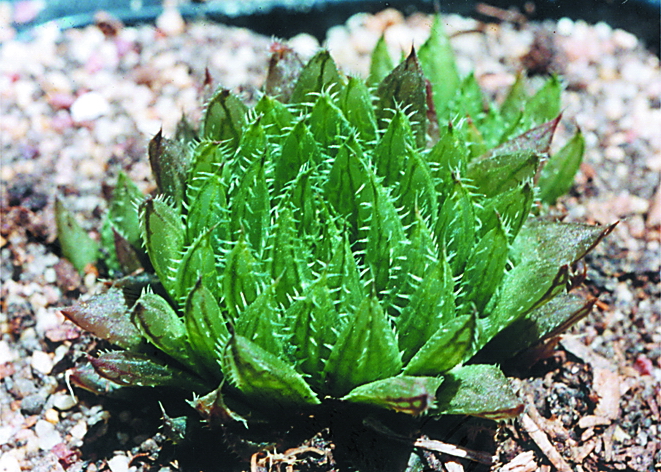
163 a. MBB6619 H. decipiens var. minor / H. arachnoidea var. xiphiophylla, Sapkamma. 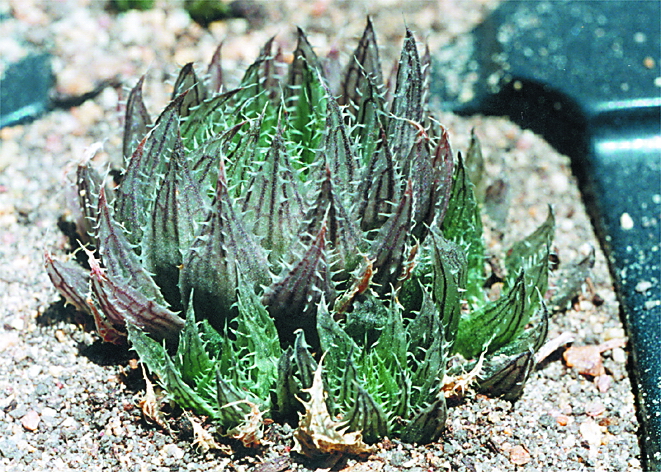
163 b. MBB6619 H. decipiens var. minor / H. arachnoidea var. xiphiophylla, Sapkamma. 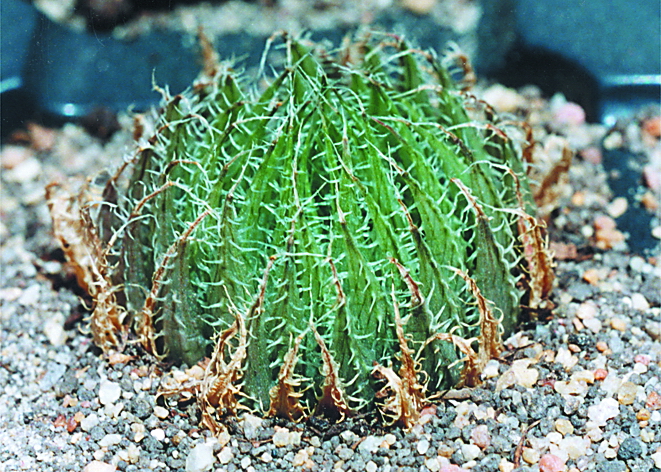
164 a. MBB6620 H. decipiens var. minor / H. arachnoidea var. xiphiophylla, Sapkamma. 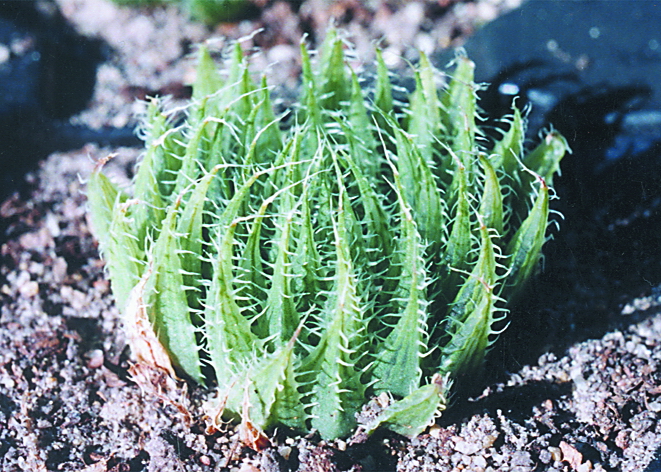
164 b. MBB6620 H. decipiens var. minor / H. arachnoidea var. xiphiophylla, Sapkamma. 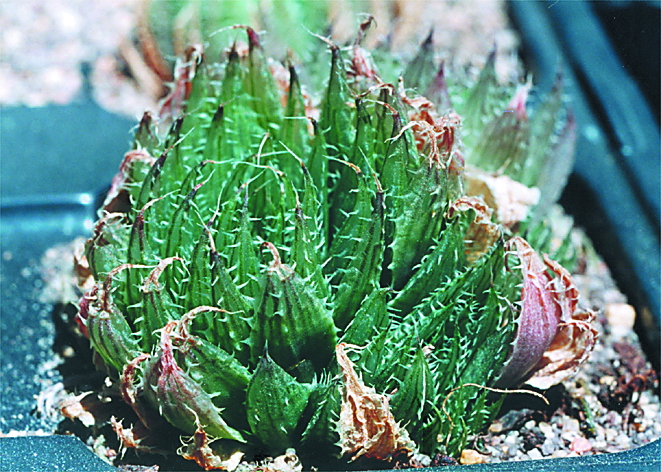
164 c. MBB6620 H. decipiens var. minor / H. arachnoidea var. xiphiophylla, Sapkamma. 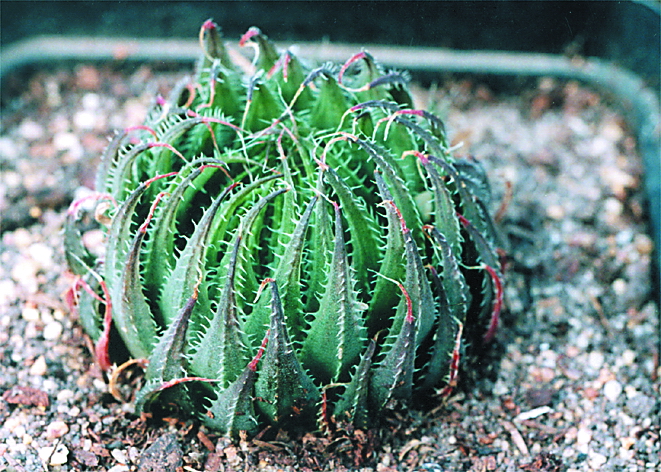
164 d. MBB6620 H. decipiens var. minor / H. arachnoidea var. xiphiophylla, Sapkamma. 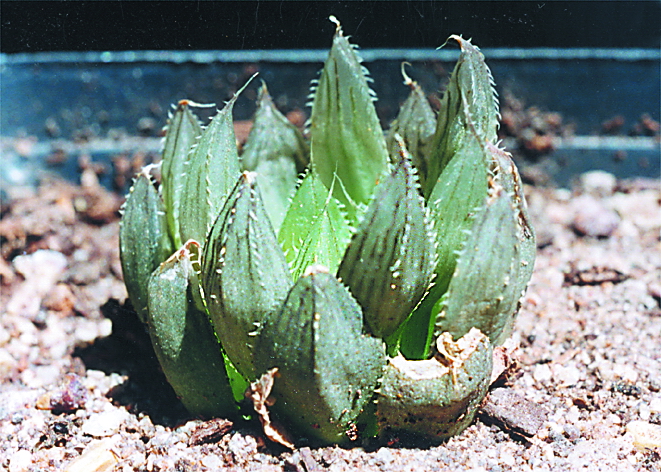
165. PD2309 H. gracilis var. isabellae to H. cooperi var. cooperi, southern end of Kaboegapoort.
Discussion
It is apparent to me that there are can be only two elements (species) of the sub-genus Haworthia present on Kaboega. These are from either of the geographical elements cymbiformis, aristata, gracilis and/cooperi, and they are directly continuous. In cultivation it is apparent and obvious to me, that aristata from Spitzkop (-141) is mirrored by the gracilis-like -152, which is continuous with the more gracilis-like -151. This latter element leads through several collections to the cymbiformis-like plants in -150, -158 and -159. Similarly a very cooperi-like element in -148 is the apparent ecotype of the very gracilis-like -149. But -148 (and -165) must also be compared with -152 and to -153, which take us back to the gracilis-like archetypes. More significantly these seem to be the elements which best relate to the collections from Oudekraal, and with what occurs still further east at Zuurberg. These collections are considered to be H. cooperi var. pilifera.
There is no doubt that the Spitzkop aristata (-141) must be compared with -155 at Paddafontein and thus connecting aristata to the greater Jansenville area, and to the western elements of H. decipiens var. pringlei. There is the Waterford collection north of Lake Mentz (MBB6855-154) which is problematic as it does not have the opacity nor darker blue-green colouration of pringlei. It is better compared with xiphiophylla (or perhaps this is H. decipiens var. minor) in 72.2 south of Lake Mentz. It also bears a remarkable likeness to the Krom River collection of gracilis var. isabelllae (-39) as indicated above.
Conclusions
I conclude that at Kaboega we have a situation where cooperi is excluded by the fact that the archetypal gracilis is represented by an advanced version of gracilis from which aristata and cymbiformis are extended. This pattern of identifications and classification true for one area, are not true for another. Already fully aware of the complex interaction between species like H. bolusii, H. cooperi and H. decipiens, and fast becoming even more aware of the extension of this complexity to H. gracilis, H. cymbiformis, H. arachnoidea var. xiphiophylla and even H. marumiana, I have to express conclusions very guardedly. Any classification of Haworthia will undoubtedly have tensions within it. It has been long apparent to me that sophisticated technology is unlikely to prove of much value in dealing with the nuance of variation between populations. If it is, it has going to have to first take into account the kind of variation one sees at the scale covered by this article. My belief was, and is now confirmed, that this is indeed the scale at which observation is now required. It can still be a lot closer. We did not spend sufficient time at Kaboega to explore the area thoroughly, and neither have we yet made any permanent record of our observations other than this report and accompanying illustrations.. The point may now have been passed at which casual generalisation from a memory bank of images is possible. Extensive photographic and herbarium records are going to be essential to create a physical record which can be studied and manipulated. There is a series of eight mountain ranges from near the coast, with the Zuurbergs being the last of these in the north-east. If I calculate how long it would take to explore that area on the scale of our limited survey of Kaboega, I reckon on at least three years of continual search.
At this point I realise that the expectations of “Haworthia Revisited” are not going to be met. There are already snivels and meuls because there is no “data” in my revision. My experience tells me that this is not because the average reader would in fact take any cognisance of such data – but it is part of the illogical and faulty paradigm of modern “science” (“materialism”, the Theosophist would say). My conviction is that I have in my revision presented there a very comprehensive picture of the genus. This can definitely meet the time-worn wishful thought of the platitudinous foreword that “this book will stimulate/encourage/direct/guide further research”. Classification of Haworthia is not simply sorting a few single specimens as they are represented in collections or on herbarium sheets. It is trying to understand a complex system of closely interrelated and similar looking elements, as populations, which do not fit a classic and static image of a genus and so-many discrete species. My contention is that this is not only the case for Haworthia, but for many other genera too.

141 a. MBB6916 H. aristata, Spitzko[, Kaboega. 
141 b. MBB6916 H. aristata, Spitzko[, Kaboega. 
141 c. MBB6916 H. aristata, Spitzko[, Kaboega. 
142 a. MBB6917 H. aristata, Kaboega. 
142 b. MBB6917 H. aristata, Kaboega. 
142 c. MBB6917 H. aristata, Kaboega. 
143 a. MBB6901 H. aristata, Hopewell. 
143 b. MBB6901 H. aristata, Hopewell. 
144 a. T.Dold3961 in MBB6921 H. cooperi var. leightonii to H. arista, Chalumna. (H. cooperi var. doldii – ed.) 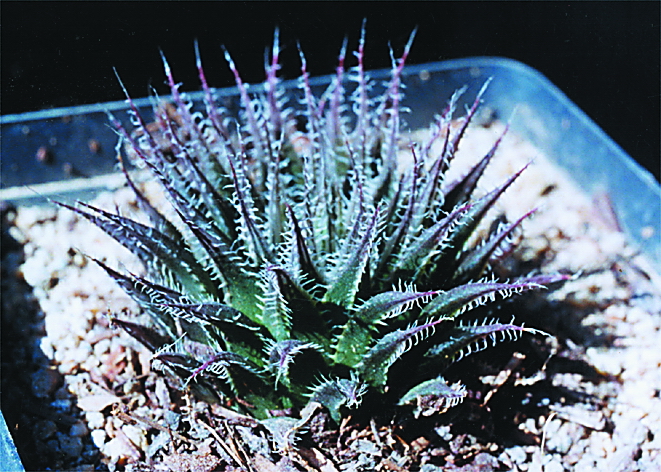
144 b. T.Dold3961 in MBB6921 H. cooperi var. leightonii to H. aristata, Chalumna. (now H. cooperi var. doldii – ed.) 
145 a. J.G.Marx in JDV91/14 H. cooperi var. cooperi, De Plaat, north aspect, Zuurberg. 
145 b. J.G.Marx in JDV91/14 H. cooperi var. cooperi, De Plaat, north aspect, Zuurberg. 
145 a. J.G.Marx in JDV91/14 H. cooperi var. cooperi, De Plaat, north aspect, Zuurberg. 
145 d. J.G.Marx in JDV91/14 H. cooperi var. cooperi, De Plaat, north aspect, Zuurberg. 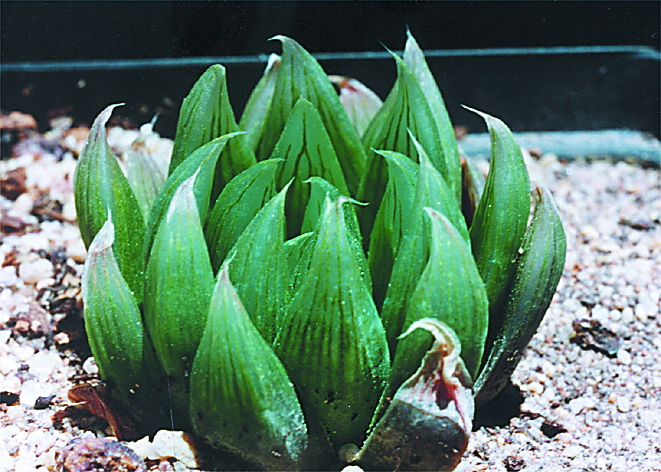
146. J.G.Marx in JDV91/15 H. cooperi var. cooperi, De Plaat, south aspect, Zuurberg. 
147 a. PVB5002 in JDV92/33 H. cooperi var. cooperi, Kaboegapoort cf [51 a-c]. 
147 b. PVB5002 in JDV92/33 H. cooperi var. cooperi, Kaboegapoort cf [51 a-c]. 
147 c. PVB5002 in JDV92/33 aberrant. 
147 d. PVB5002 in JDV92/33 cf [20, 154 a-c]. 
147 e. PVB5002 in JDV92/33 cf.095 [96 a, b, 116a-e]. 
147 f. PVB5002 in JDV92/33 cf.095 [96 a, b, 116a-e]. 
148 a. MBB6904 H. cooperi var. cooperi, in amongst grass, Wilgefontein, west of Kaboega. 
148 b. MBB6904 H. cooperi var. cooperi, in amongst grass, Wilgefontein, west of Kaboega. 
148 c. MBB6904 H. cooperi var. cooperi, in amongst grass, Wilgefontein, west of Kaboega. 
148 d. MBB6904 H. cooperi var. cooperi, in amongst grass, Wilgefontein, west of Kaboega. 
148 e. MBB6904 H. cooperi var. cooperi, in amongst grass, Wilgefontein, west of Kaboega. 
149 a. MBB6905 H. gracilis var. isabellae, on rock face, Wilgefontein, westof Kaboega. 
149 b. MBB6905 H. gracilis var. isabellae, on rock face, Wilgefontein, westof Kaboega. 
149 c. MBB6905 H. gracilis var. isabellae, on rock face, Wilgefontein, westof Kaboega. 
149 d. MBB6905 H. gracilis var. isabellae, Wilgefontein, west of Kaboega. 
149 e. MBB6905 H. gracilis var. isabellae, Wilgefontein, west of Kaboega. 
149 f. MBB6905 H. gracilis var. isabellae, Wilgefontein, west of Kaboega. 
149 g. MBB6905 H. gracilis var. isabellae, Wilgefontein, west of Kaboega. 
150. MBB6903 H. cymbiformis var. cymbiformis. south-facing rocks, Wilgefontein. 
151. MBB6909 H. cooperi var. cooperi, southwest fo De Plaat farmhouse. 
152 a. MBB6910 H. gracilis var. isabellae to H. cooperi var. cooperi, east of De Plaat farmhouse. 
152 b. MBB6910 H. gracilis var. isabellae to H. cooperi var. cooperi, east of De Plaat farmhouse. 
153. MBB6911 H. gracilis var isabellae to H. cooperi var. cooperi, rock faces in Kaboegapoort. 
154 a. MBB6855 H. arachnoidea var. xiphiophylla to H. decpiens var. minor, Waterford, east of Janesville. 
154 b. MBB6855 H. arachnoidea var. xiphiophylla to H. decpiens var. minor, Waterford, east of Janesville. 
154 c. MBB6855 H. arachnoidea var. xiphiophylla to H. decpiens var. minor, Waterford, east of Janesville. 
155. MBB6899 H. aristata / H. decipiens var. pringlei, Paddafontein, north of Kaboega. 
156 a. MBB6914 H. cooperi var. cooperi / H. cymbiformis, east of Spekboomberg, northwest of Kaboega. 
156 b. MBB6914 H. cooperi var. cooperi / H. cymbiformis, east of Spekboomberg, northwest of Kaboega. 
156 c. MBB6914 H. cooperi var. cooperi / H. cymbiformis, east of Spekboomberg, northwest of Kaboega. 
157 a. MBB6915 H. cooperi var. cooperi / H. cymbiformis, Kok-se-dam, Kaboega. 
157 b. MBB6915 H. cooperi var. cooperi / H. cymbiformis, Kok-se-dam, Kaboega. 
158 a. MBB6925 H. cymbiformis var. cymbiformis, Kok-se-pad. 
158 b. MBB6925 H. cymbiformis var. cymbiformis, Kok-se-pad. 
158 c. MBB6925 H. cymbiformis var. cymbiformis, Kok-se-pad. 
158 d. MBB6925 H. cymbiformis var. cymbiformis, Kok-se-pad. 
158 e. MBB6925 H. cymbiformis var. cymbiformis, Kok-se-pad. 
159 a. MBB6935 H. cooperi var. cooperi / H. cymbiformis, south of De Plaat farmhouse. 
159 b. MBB6935 H. cooperi var. cooperi / H. cymbiformis, south of De Plaat farmhouse. 
160 a. MBB6922 H. cooperi var. cooperi. Oudekraal, Zuurberg. 
160 b. MBB6922 H. cooperi var. cooperi. Oudekraal, Zuurberg. 
160 c. MBB6922 H. cooperi var. cooperi. Oudekraal, Zuurberg. 
161. PVB2310 H. decipiens var. major, Boplas, northeast of Kirkwood. 
162 a. MBB6618 H. decipiens var. minor / H. arachnoidea var. xiphiophylla, Sapkamma, south of Perdepoort. 
162 b. MBB6618 H. decipiens var. minor / H. arachnoidea var. xiphiophylla, Sapkamma, south of Perdepoort. 
163 a. MBB6619 H. decipiens var. minor / H. arachnoidea var. xiphiophylla, Sapkamma. 
163 b. MBB6619 H. decipiens var. minor / H. arachnoidea var. xiphiophylla, Sapkamma. 
164 a. MBB6620 H. decipiens var. minor / H. arachnoidea var. xiphiophylla, Sapkamma. 
164 b. MBB6620 H. decipiens var. minor / H. arachnoidea var. xiphiophylla, Sapkamma. 
164 c. MBB6620 H. decipiens var. minor / H. arachnoidea var. xiphiophylla, Sapkamma. 
164 d. MBB6620 H. decipiens var. minor / H. arachnoidea var. xiphiophylla, Sapkamma. 
165. PD2309 H. gracilis var. isabellae to H. cooperi var. cooperi, southern end of Kaboegapoort.

Pingback: South Africa 3 | Town and country: aiming for ecological restoration at the landscape scale | Natural History of Ecological Restoration
Pingback: Kaboega - Haworthia Updates
Pingback: Volume 6, Chapter 3:- Still more about Haworthia on Kaboega | Haworthia Updates